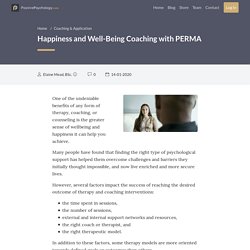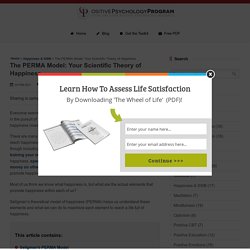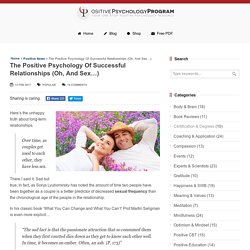

To flourish is to find fulfillment in our lives, accomplishing meaningful and worthwhile tasks, and connecting with others at a deeper level—in essence, living the “good life” (Seligman, 2011). Happiness and Well-Being Coaching with PERMA. One of the undeniable benefits of any form of therapy, coaching, or counseling is the greater sense of wellbeing and happiness it can help you achieve.

Many people have found that finding the right type of psychological support has helped them overcome challenges and barriers they initially thought impossible, and now live enriched and more secure lives. However, several factors impact the success of reaching the desired outcome of therapy and coaching interventions: the time spent in sessions,the number of sessions,external and internal support networks and resources,the right coach or therapist, andthe right therapeutic model. In addition to these factors, some therapy models are more oriented towards defined goals or outcomes than others. In this article, we’ll be exploring the PERMA model, developed by Martin Seligman, which has a more defined purpose in supporting individuals to achieve a fulfilled sense of happiness and well-being. What is the PERMA Model? 1. 2. 3. 4. 5. 1. For example: The PERMA Model: Your Scientific Theory of Happiness. Everyone seems to be in the pursuit of happiness nowadays.

There are many ways to reach happiness, though including training your mind for happiness, spending money on others to promote happiness, and following the code to well-being and happiness. Most of us think we know what happiness is, but what are the actual elements that promote happiness within each of us? Seligman’s theoretical model of happiness (PERMA) helps us understand these elements and what we can do to maximize each element to reach a life full of happiness.
Download The Wheel of Life (PDF) For Free Learn How To Accurately Assess Your (Client's) Life Satisfaction in All Life Domains To the point, easy to read and print (9 page PDF) Written by academics, 100% science-based Includes visual 'Wheel of Life' + how to apply it Yes, please send me the Wheel of Life Seligman’s PERMA Model The PERMA model was designed by Martin Seligman with five core element of psychological well-being and happiness.
P – Positive Emotion E – Engagement. The Positive Psychology Of Successful Relationships (Oh, And Sex...) Home » Positive News » The Positive Psychology Of Successful Relationships (Oh, And Sex…) Here’s the unhappy truth about long-term relationships.

Over time, as couples get used to each other, they have less sex. There I said it. Sad but true. In fact, as Sonja Lyubomirsky has noted the amount of time two people have been together as a couple is a better predictor of decreased sexual frequency than the chronological age of the people in the relationship. In his classic book ‘What You Can Change and What You Can’t’ Prof Martin Seligman is even more explicit… “The sad fact is that the passionate attraction that so consumed them when they first courted dies down as they get to know each other well. Seligman uses the term ‘Acedia’ (from the Greek, roughly translated as sloth and neglect) to describe this phenomenon. So what does Positive Psychology say about keeping the passion alive? The Positive Psychology Toolkit Become a Science-Based Practitioner! Soften your “start-up.” Positive Emotions.
Toxic Relationships. Meaning. Self-Achievement. How to Find Happiness in Today's World. Cheavens, J.

S., Feldman, D. B., Gum, A., Michael, S. T., & Snyder, C. R. (2006). Hope therapy in a community sample: A pilot investigation. Harzer, C., & Ruch, W. (2016). Hone, L. Kashdan, T. Keyes, C. Lambert, N. Langer, E. (2006). Niemiec, R. Positive Psychology in the Workplace: Thank God it's Monday. We all want work to be a positive and engaging experience. Who doesn’t dream of waking up on a Monday excited to go to work? Positive Psychology has shown how positive emotions are linked with numerous benefits including improved health, wellbeing, longevity, and a greater quality of life. On the flip side anger, anxiety, depression, and worry are related to poor health outcomes. Our genes are responsible for about 50% of our happiness levels, our actions and attitudes account for 40% or our happiness. So if our choices and attitudes have a significant impact in our happiness, how do we cultivate and maintain a state of positivity and well-being in the workplace?
Watch the video and find out: Benefits of Positive Psychology in the Workplace Positive psychology can be used in many different ways to increase happiness and satisfaction within the workforce.